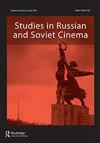Sergueï Loznitsa. Un cinéma à l’épreuve du monde
IF 0.4
0 FILM, RADIO, TELEVISION
引用次数: 1
Abstract
and temporal relationship between China and revolutionary Russia’ (143) that Soviet filmmakers wanted to create and their desire to make both films about China and films to exhibit in China (in order to radicalise Chinese audiences). This chapter ranges widely, from the animated film China in Flames (Kitai v ogne) to Vladimir Shneiderov’s 1925 expedition film The Great Flight (Velikii perelet), to Tret’iakov’s own, unmade project with Sergei Eisenstein and Eduard Tisse, Dzhungo, to the 1928 documentary Shanghai Document (Shangkhaiskii dokument) and Isaak Babel”s script for the now lost film The Chinese Mill (Kitaiskaia mel’nitsa), in which humour undermines international solidarity. Chapter 4 considers Den Shi-khua, Tret’iakov’s extensive ‘bio-interview’ of one of his Chinese students, a work that evolved over a decade of new editions in the late 1920s and early 1930s, entailing the articulation and elaboration of a new theory of both writing and reading. This complex text requires a complex analysis, a task for which Tyerman is supremely well equipped. The book’s epilogue takes the story further into the 1930s, through the work of the Chinese returnees from Moscow and, in Russia, through the journal International literature and the contribution of two Chinese intermediaries, the poet and translator Xiao San (Emi Siao) and the Peking opera actor Mei Lanfang. It concludes with numbing details on the way in which the arrests and executions of the 1930s decimated the ranks of those involved in the political and cultural reception of the Chinese revolutionary movement. Internationalist aesthetics is a staggeringly erudite, formidably argued and fundamentally important book about which a great deal more could be written than I have space for here. Its case study of political and cultural exchange between nations provides a model for approaching such issues in other areas and epochs and is particularly relevant at the present time of political and cultural competition and the battles for influence.谢尔盖·洛兹尼察。世界测试的电影
以及苏联电影制作人想要创作的《中国和革命俄罗斯之间的时间关系》(143),以及他们想要制作关于中国的电影和在中国展出的电影的愿望(以激进化中国观众)。这一章涉及面很广,从动画电影《火焰中的中国》(Kitai v ogne)到弗拉基米尔·施奈德罗夫1925年的探险电影《伟大的飞行》(Velikii perelet),再到特雷季亚科夫自己与谢尔盖·艾森斯坦和爱德华·蒂塞、,1928年的纪录片《上海文件》(Shangkhaiskii dokument)和伊萨克·巴贝尔为现已失传的电影《中国工厂》(Kitaiskaia mel'nitsa)编写的剧本,其中幽默破坏了国际团结。第四章论述了特列季亚科夫对他的一名中国学生的广泛“个人访谈”《登世华》,这部作品在20世纪20年代末和30年代初经过了十多年的新版发展,包含了一种新的写作和阅读理论的阐述和阐述。这个复杂的文本需要一个复杂的分析,而Tyerman完全有能力完成这项任务。这本书的后记通过从莫斯科返回的中国人的作品,以及在俄罗斯的《国际文学》杂志,以及诗人兼翻译家小三(Emi Siao饰)和京剧演员梅兰芳这两位中国中间人的贡献,将故事进一步带入了20世纪30年代。它以令人麻木的细节结尾,讲述了20世纪30年代的逮捕和处决如何摧毁了那些参与中国革命运动政治和文化接受的人。《国际美学》是一本博学多才、争论不休、具有根本重要性的书,关于这本书,我可以写的东西比我在这里的篇幅多得多。它对国家间政治和文化交流的案例研究为在其他领域和时代处理这些问题提供了一个模式,在当前政治和文化竞争以及影响力争夺战中尤为重要。
本文章由计算机程序翻译,如有差异,请以英文原文为准。
求助全文
约1分钟内获得全文
求助全文

 求助内容:
求助内容: 应助结果提醒方式:
应助结果提醒方式:


